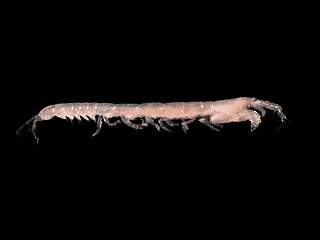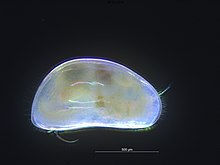
The Heteroptera are a group of about 40,000 species of insects in the order Hemiptera. They are sometimes called "true bugs", though that name more commonly refers to the Hemiptera as a whole. "Typical bugs" might be used as a more unequivocal alternative, since the heteropterans are most consistently and universally termed "bugs" among the Hemiptera. "Heteroptera" is Greek for "different wings": most species have forewings with both membranous and hardened portions ; members of the primitive sub-group Enicocephalomorpha have completely membranous wings.

The Osmeriformes are an order of ray-finned fish that includes the true or freshwater smelts and allies, such as the galaxiids and noodlefishes; they are also collectively called osmeriforms. They belong to the teleost superorder Protacanthopterygii, which also includes pike and salmon, among others. The order's name means "smelt-shaped", from Osmerus + the standard fish order suffix "-formes". It ultimately derives from Ancient Greek osmé + Latin forma, the former in reference to the characteristic aroma of the flesh of Osmerus.

Ostracods, or ostracodes, are a class of the Crustacea, sometimes known as seed shrimp. Some 33,000 species have been identified, grouped into 7 valid orders. They are small crustaceans, typically around 1 mm (0.04 in) in size, but varying from 0.2 to 30 mm in the case of the marine Gigantocypris. The largest known freshwater species is Megalocypris princeps, which reach 8mm in length. In most cases, their bodies are flattened from side to side and protected by a bivalve-like valve or "shell" made of chitin, and often calcium carbonate. The family Entocytheridae and many planktonic forms do not have calcium carbonate. The hinge of the two valves is in the upper (dorsal) region of the body. Ostracods are grouped together based on shell and soft part morphology. While early work indicated the group may not be monophyletic and early molecular phylogeny was ambiguous on this front, recent combined analyses of molecular and morphological data suggested monophyly in analyses with broadest taxon sampling, but this monophyly had no or very little support. They have a wide range of diets, and the class includes carnivores, herbivores, scavengers and filter feeders, but most ostracods are deposit feeders.

Isopoda is an order of crustacean, which includes woodlice and their relatives. Members of this group are called Isopods and include both terrestrial and aquatic species. All have rigid, segmented exoskeletons, two pairs of antennae, seven pairs of jointed limbs on the thorax, and five pairs of branching appendages on the abdomen that are used in respiration. Females brood their young in a pouch under their thorax.

The crustacean order Tanaidacea make up a minor group within the class Malacostraca. There are about 940 species in this order.

Feliformia is a suborder within the order Carnivora consisting of "cat-like" carnivorans, including cats, hyenas, mongooses, viverrids, and related taxa. Feliformia stands in contrast to the other suborder of Carnivora, Caniformia.

The Podocopa are a subclass of ostracods. Members of the subclass Podocopa can be differentiated from the other subclass of ostracods (Myodocopa) by the morphology of the second antenna: the Podocopa have a relatively long endopod, whereas the Myodocopa have a relatively long exopod. The seventh limb of the Podocopa has a variety of forms or is absent, but is never an annulated worm-like limb.

Taxonomy of commonly fossilised invertebrates is a complex and evolving field that combines both traditional and modern paleozoological terminology. This article aims to provide a comprehensive overview of the various invertebrate taxa that are commonly found in the fossil record, from protists to arthropods. The taxonomy presented here is not intended to be exhaustive but focuses on invertebrates that are either popularly collected as fossils or are extinct. Special notations are used to highlight invertebrate groups that are important as fossils, very abundant in the fossil record, or have a large proportion of extinct species. These notations are explained below for clarity:

The Prostigmata is a suborder of mites belonging to the order Trombidiformes, which contains the "sucking" members of the "true mites" (Acariformes).

The Argentiniformes are an order of ray-finned fish whose distinctness was recognized only fairly recently. In former times, they were included in the Osmeriformes as suborder Argentinoidei. That term refers only to the suborder of marine smelts and barreleyes in the classification used here, with the slickheads and allies being the Alepocephaloidei. These suborders were treated as superfamilies Argentinoidea and Alepocephaloidea, respectively, when the present group was still included in the Osmeriformes.

Cyprididae is "the most diverse group of freshwater ostracods". It contains over 1000 species, which represents 50% of the known species of freshwater ostracods. Around 60% of genera in the family are endemic to a single zoogeographic region. The family contains 16 subfamilies, and is most diverse in the Afrotropical realm, with over 300 species in 45 genera. Many Cyprididae occur in temporary water bodies and have drought-resistant eggs, mixed/parthenogenetic reproduction and ability to swim. These biological attributes pre-adapt them to form successful radiations in these habitats. Bennelongia is an interesting of the family Cyprididae. It may be the last true descendant of the Mesozoic lineage of Cypridea, which was a dominant lineage of ostracod in non-marine waters in the Cretaceous.

Candonidae is a family of ostracods, containing around 25% of all known species of freshwater ostracods. Around 75% of genera in the family are endemic to a single zoogeographic region. It contains more than 500 species, of which more than 300 are endemic to the Palearctic realm.

Cypridocopina is a suborder of ostracods in the order Podocopida. It is divided into three superfamilies – Cypridoidea, Macrocypridoidea and Pontocypridoidea.
Bennelongia is a genus of ostracod crustaceans in the family Cyprididae. It is probably endemic to Australia and New Zealand, and is predicted to be highly diverse. The genus was described in 1981 and named after Woollarawarre Bennelong, the first aboriginal to have a long association with the early European settlers of Australia. Prior to 2012, six species were described in Australia. There are currently 15 species of Bennelongia. Bennelongia may be the last true descendant genus of the Mesozoic lineage of Cypridea, which was a dominant lineage of ostracod in non-marine waters in the Cretaceous.

Christian Gustav Wilhelm Müller was a German zoologist specializing in Ostracoda.
Palaeocopida is an order of ostracods in the subclass Podocopa. Most species in the suborder are extinct, and only the genera Manawa, Promanawa and Puncia in the family Punciidae are extant. The members of the family lives in high-energy shallow marine environments of New Zealand.
Cypricercus elegans is a species of freshwater ostracod in the family Cyprididae. It is found in Colombia.
Chlamydotheca elegans is a species of freshwater ostracods in the family Cyprididae. It is found in Colombia.
Krithidae is a family of marine ostracods belonging to the superfamily Cytheroidea (suborder Cytherocopina in the order Podocopida.
Franciszek Adamczak was a Polish–Swedish palaeontologist who made major contributions to the study of Palaeozoic ostracods.














